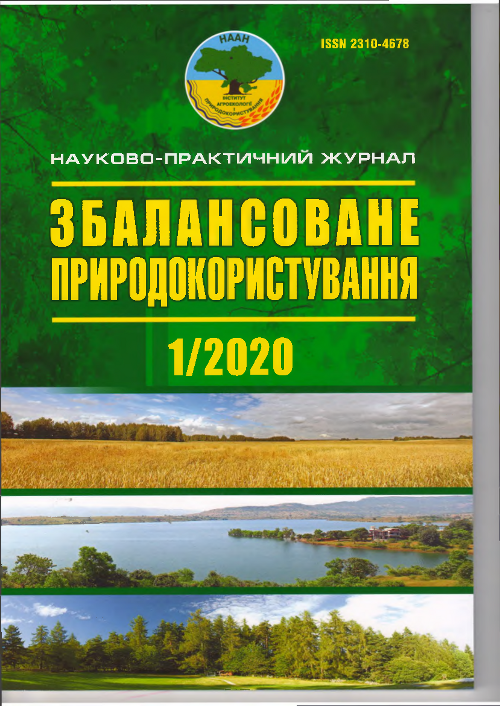THE USE OF UNMANNED AERIAL VEHICLES TO EVALUATE THE TECHNOLOGICAL STRESS OF WHEAT WINTER
DOI:
https://doi.org/10.33730/2310-4678.1.2020.203933Keywords:
monitoring, unmanned aerial vehicles, herbicide aftereffect, wheat winterAbstract
The article deals with the applied aspects of the use of UAVs, namely the monitoring of winter wheat crops in relation to the stresses caused by the herbicide effects. The effects of herbicides are understood to mean the effects of herbicide residues left over from the precursor culture that cause a stressful condition in new crops. The issue has local specificity related to the inconsistency of plant cultivation technologies and the lack of study of the effects of the latest plant protection products in domestic soil conditions. Restoration of crop yields is possible with timely identification of causes of stress, but decision-making time is limited, requiring the introduction of up-to-date industrial monitoring technologies. The purpose of the research is to improve the methodology of operational monitoring using UAVs of winter crops for example wheat in relation to the effects of herbicide aftereffects. The experiments were carried out under laboratory conditions and in production fields for Mulan wheat. In laboratory studies using phytocameras it was not possible to establish for spectral or spectral spatial methods clear criteria that clearly indicated the stress caused by the herbicide effect. Field studies using the Slantrange UAV DJI Matrice 200 as an object of study analyzed the distribution of stress areas in the field. The experiments were conducted in 2018 at production fields in the Kiev region. It has been shown that maps of stress indices obtained from a high-resolution UAV database can be considered as a separate research object for the interpretation of stress causes of complex biotechnical objects such as crops. It has been established that monitoring and reliability of monitoring data can be achieved through the implementation of data processing and computer training systems to find correlation between the stress distribution of plants in the field and the execution of technological operations, terrain, etc.
References
Andújar, D., Moreno, H., Bengochea-Guevara, J.M. et al. (2019). Aerial imagery or on-ground detection? An economic analysis for vineyard crops. Computers and Electronics in Agriculture. 157: 351–358.
Machado, S.C., Martins, I. (2018). Risk assessment of occupational pesticide exposure: Use of endpoints and surrogates. Regulatory Toxicology and Pharmacology. 98: 276–283.
Yao H., Huang Y., Hruskaa Z. et al. (2012). Using vegetation index and modified derivative for early detection of soybean plant injury from glyphosate. Computers and Electronics in Agriculture. 89:145–157.
Jursík ,M., Kolářová ,M., Soukup, J. (2019). Competition, reproduction ability, and control possibilities of conventional and Clearfield volunteer oilseed rape in winter wheat. Crop Protection. 122: 30–34.
Zimdahl R.L. (2018). Chapter 16 Properties and Uses of Herbicides. Fundamentals of Weed Science (Fifth Edition): 463–499.
Green, D.R., Hagon, J.J., Gómez, C., Gregory, B.J. (2019). Chapter 21. Using Low-Cost UAVs for Environmental Monitoring, Mapping, and Modelling: Examples From the Coastal Zone. Coastal Management Global Challenges and Innovations: 465–501.
Deng, L., Mao, Z., Li, X., Hu, Z., Duan, F. et al. (2018) UAV-based multispectral remote sensing for precision agriculture: A comparison between different cameras. ISPRS Journal of Photogrammetry and Remote Sensing. 146:124–136.
Lysenko, V., Komarchuk D., Opryshko O. et al. (2017). Determination of the not uniformity of illumination in process monitoring of wheat crops by UAVs. 4th International Scientific-Practical Conference Problems of Infocommunications. Science and Technology (PIC S&T): 265–267.
Korobiichuk, I., Lysenko, V., Opryshk,o O., Komarchyk, D. et al. (2018). Crop monitoring for nitrogen nutrition level by digital camera Automation 2018. Advances in Intelligent Systems and Computing. Springer, Cham: 595–603.
Enciso, J., Avila, C., Jung ,J., Elsayed-Farag, S., Chang A. et al. (2019). Validation of agronomic UAV and field measurements for tomato varieties. Computers and Electronics in Agriculture. 158: 278–283.
Duan, T., Chapman, S.C., Guo, Y., Zheng, B. (2017). Dynamic monitoring of NDVI in wheat agronomy and breeding trials using an unmanned aerial vehicle. Field Crops Research. 210: 71–80.
Lysenko, V., Opryshko, O., Komarchuk, D., Pasichnyk, N. (2017). Usage of Flying Robots for Monitoring Nitrogen in Wheat Crops. The 9th IEEE International Conference on Intelligent Data Acquisition and Advanced Computing Systems: Technology and Applications 21–23 September. Bucharest Romania. 1: 30–34.
Yue, J., Yang, G., Tian, Q., Feng, H. et al. (2019). Estimate of winter-wheat above-ground biomass based on UAV ultrahigh-ground-resolution image textures and vegetation indices. ISPRS Journal of Photogrammetry and Remote Sensing. 150: 226–244.
Lysenko, V., Opryshko, O., Komarchuk, D. et al. (2018). Information Support Of The Remote Nitrogen Monitoring System In Agricultural Crops. International Journal of Computing. 17(1): 47–54.
Calderón, R., Navas-Cortés, J.A., Lucena, C., Zarco-Tejada P.J. (2013). High-resolution airborne hyperspectral and thermal imagery for early detection of Verticilliumwilt of olive using fluorescence, temperature and narrow-band spectral indices. Remote Sensing of Environment. 139: 231–245.
Downloads
Published
Issue
Section
License
- The authors reserve the right to authorship their work and pass the journal the right to publish this work under a Creative Commons Attribution License license, which allows other persons to freely distribute the published work with the obligatory The authors of the original work and the first publication of this magazine.
- The authors have the right to make independent additional agreements on the nonexclusive dissemination of the work in the form in which it was published by this magazine (for example, to post work in the company's electronic storage or to publish as a monograph) , subject to the first publication of the link to this journal.
- Journal policy allows and encourages the placement of authors on the Internet (for example, in the repositories of institutions or on personal websites) manuscript work as to the presentation of this manuscript to the editorial board and during its editorial processing, as it contributes to The productive scientific discussion and positively affects the efficiency and dynamics of citation published work (see The Effect of Open Access).


